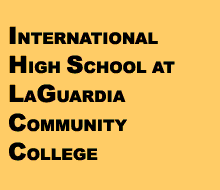 "With this level of decision-making power, we have very, very few excuses for not doing the job." Students can only be admitted to International High School in the New York City district if their English language skills are in the bottom 20 percent citywide and they have been in this country for fewer than four years. It is an admissions test that most students in New York might wish they could pass. At International, students beat the district average in course pass rates, four-year graduation rates, and retention "rates (only 1.7 percent drop out of high school, compared with 16.4 percent districtwide). Over 90 percent of International graduates are accepted into college. Several years ago, the teachers at International found students' limited English language ability to be a persuasive reason to organize the school into small teams and to organize the curriculum for interdisciplinary depth. "A couple of experimental teams were formed," one teacher explains, "and their students were getting better results, doing more sophisticated work. As a school, we decided, okay, this is the way we're going to go." Now, six teams of six teachers each have extraordinary authority to manage the education of their particular 75 students for the year. "I'm amazed at how much power is given to teams to make decisions," says a teacher who came to International after 17 years in other schools. Another teacher points out the corollary, "It's wonderful," she says, "but you see the problem – there are no excuses. With this level of decision-making power, we have very, very few excuses for not doing the job." "The job" that teachers do begins not in their classrooms, but in their teams. Each team meets three hours a week, to develop and revise their interdisciplinary curriculum, share successful practices and troubleshoot problems, allocate a team budget, hire and mentor new teachers for the team, and discuss, or case manage, individual students. If students are having trouble, International does not have a dean's office to send them to. Kids belong to the team. A third-year teacher explains, "We all see the same kids, and when there's a problem with a kid, it's everybody's problem. You can imagine, especially for a new teacher, how wonderful that is. Case management is a great way to make sure kids don't fall through the cracks." Teachers don't fall through the cracks either. In addition to the support of team members, new teachers often find themselves team teaching their first year. A new teacher reports, "Things that it takes years and years of teaching to do well, I learned from watching my master teacher and from her feedback." Additional support, in the form of peer evaluation, occurs annually for teachers' first two years at International and then every third year. "It is an opportunity for us to showcase what we're doing, to ask for help solving problems, and to find out what other teachers are doing," says one teacher. "All that opening up and talking to other people has dramatically changed how I teach," adds another teacher who had felt isolated in other schools. Teachers also write self-evaluations and create professional portfolios. According to a teacher in her sixth year of teaching, "It gives me a chance to synthesize what I've done, put it together in a coherent way, and focus on my next goals." When the staff saw how powerful portfolios were for their own learning, the teams started to move away from student tests toward having students show their work to each other and discuss it. Monthly staff meetings, as well as team meetings, have focused on how to institute graduation projects or portfolios. This has meant creating and aligning rubrics with the state standards and graduation requirements. It has also meant supporting students in every class so that by the time they are seniors, they're each prepared to create a successful portfolio. Teachers, who personally advise several seniors apiece, acknowledge how much work implementing the portfolio process has been, but also how valuable it is, for teachers as well as students. Says one teacher, "I can't overemphasize how important this has been and how much we learn from it." "The key to school reform is learning," says principal Eric Nadelstern. "All new learning creates change. If your goal for students is to show that education can transform your life, you must have a school culture that demonstrates that adults are capable of learning. We model a structure where teachers can learn." |
Grades 9-12 Number of Students 450 Student Ethnicity 45% Latino 30% Asian 22% White 2% African American English Language Learners 73%* ( * 100% when admitted, 37 different languages) Free/Reduced Lunch 82% Special Needs 0% Measures of Success increased increased increased college narrowed ELL
31-10 Thomson Avenue Long Island City, NY 11101 718-482-5482
|
WestEd
WestEd Home | Search | Feedback
About WestEd | Our Work | Resources | What's New
This information can be found at
http://
Last modified
©
WestEd® | (415) 565-3000 | www.WestEd.org